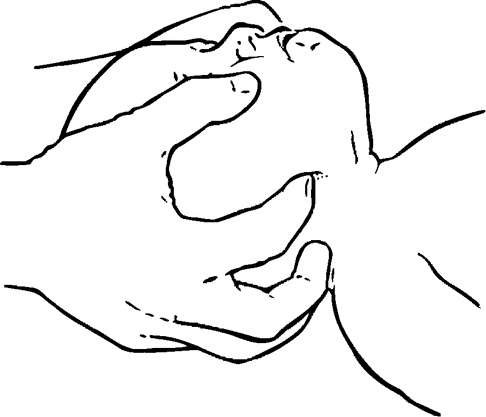Diagrammatic representation of primary and terminal apnoea following the onset of acute total asphyxia at time 0.
The next section in the graph relates to the oxygen, carbon dioxide and pH levels of the fetus. Clearly in this model, the animal has been rendered hypoxic. As such, the oxygen levels fall to a minimum and fail to respond to the rapid and increasing respiratory rate and fail to respond to the gasping. In the same way, the carbon dioxide levels begin to rise as the fetus is unable to dispose of the carbon dioxide produced. This carbon dioxide is converted to carbonic acid, which along with the increasing lactic acidosis from the hypoxia results in an excess of acid and a fall in the fetal pH. This fact is well known to those practising on a labour ward, and is the physiological basis behind the use of fetal scalp pH assessment to monitor fetal well-being during labour.
Turning to the cardiovascular responses in the hypoxic fetus, we see one of the ways in which the fetus differs from the adult. An adult rendered hypoxic for short periods would quickly develop cardiac failure and suffer a cardiac arrest. The fetus, on the other hand, is designed to cope with the hypoxia associated with birth. Each time the uterus contracts, the flow of oxygenated blood from placenta to fetus is interrupted with the well-recognized consequence of a fetal bradycardia on the CTG. The same is seen in our animal model. The initial response to the hypoxia is an increase in the heart rate, but this is followed by a fall in the heart rate, not to zero as in the adult but to a rate of around 80 beats per minute (bpm). The heart relies on its stores of glycogen for an energy source during the hypoxic episodes, and only after a prolonged period of asphyxia does the fetal heart rate (FHR) drop to very low levels and finally stop altogether.
By using other cardiovascular responses, the asphyxiated fetus aims to maintain its blood pressure. It diverts (redistributes) its blood flow away from non-essential organs (skin and splanchnic circulation) and sends it to vital organs (brain, heart, adrenals). As such, the baby who has experienced the longest period of intrauterine asphyxia will appear white and pale owing to this redistribution, the baby having vasoconstricted its peripheral circulation.
Finally, the heart can no longer continue without oxygen, and as the heart fails the blood pressure drops and the fetal heart stops.
That explains the background physiology to intrapartum asphyxia. The difficulty facing the person needing to resuscitate the baby is that they have no idea how far along this asphyxial timescale the baby has travelled in utero.
The baby born at each of the three arrows marked in Figure 26.2 presents the same clinical findings – apnoeic, bradycardic and probably pale. The basis for the resuscitation of these babies is to start by performing the actions needed to resuscitate the baby at point 1 and if there is no response, move on to those actions needed for the baby at point 2, and so on in a stepwise manner, always assessing any change in colour, tone, respiratory effort and heart rate to the particular manoeuvre that was tried.
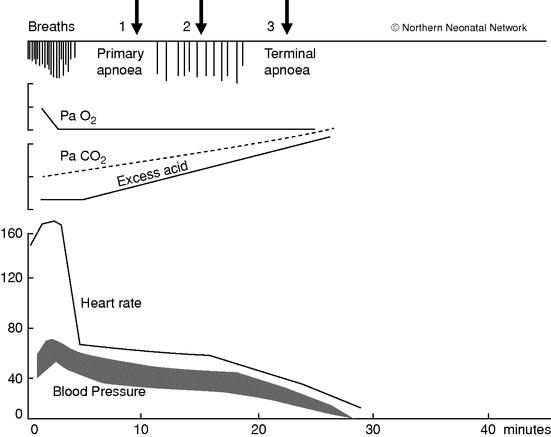
The first action in any resuscitation in the newborn, no matter how unwell the baby appears, is to get the baby wiped and dried and wrapped in warmed towels. It is far more difficult to resuscitate a cold, wet baby than it is to resuscitate a warm, dry baby.
Let us consider these babies born at different points along this asphyxial pathway and what they will need for resuscitation.
Let us consider the baby born in the primary apnoeic phase of asphyxia (Figure 26.3 – arrow 1 on Figure 26.2).
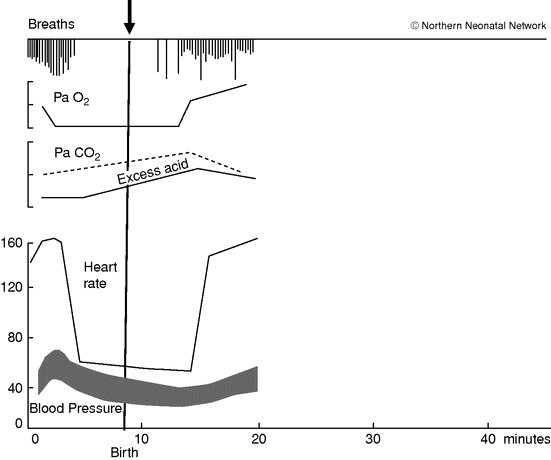
Diagrammatic representation of response to birth in primary apnoea.
We know from the physiology we have just looked at that primary apnoea is always followed by gasping respiration. Therefore we know that this baby will gasp. If, at the point of gasping, this baby has a patent airway, it will be successful in getting oxygen into its lungs. This will quickly pass into the bloodstream and as soon as it passes into the coronary arteries the heart will respond with an increase in rate and the baby will turn pink. To all intents and purposes, the baby has resuscitated itself. We will have dried and wrapped the baby. We might have needed to open or clear the airway, but the rest was down to the baby.
Second, let us consider a baby who has been hypoxic for a little longer than the first baby who has now reached the gasping phase (Figure 26.4 – arrow 2 in Figure 26.2).
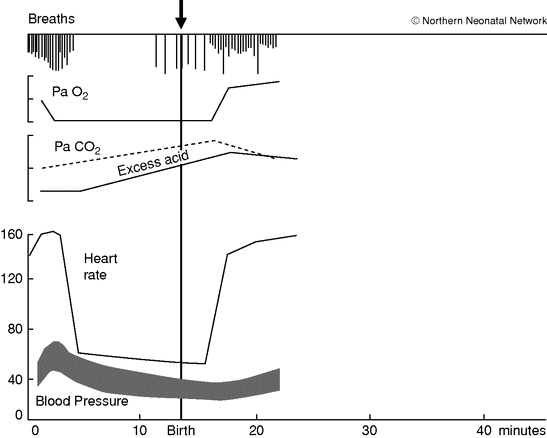
Diagrammatic representation of response to birth in gasping phase of intrapartum asphyxia.
As with the previous baby, so long as the baby continues to take gasps and has an open and patent airway, it will resuscitate itself. The gasping will draw air into the lungs which, once absorbed into the bloodstream, will pass to the coronary arteries, resulting in an increase in the heart rate and the baby turning pink. Again, we will have dried and wrapped the baby before anything else, but this baby may take a little while to re-establish a normal respiratory pattern and may need some supportive ventilation breaths but, as with the previous baby, it has to all intents and purposes resuscitated itself.
Let us thirdly consider the baby who has taken its last gasp in utero and has been delivered in the terminal apnoeic phase (Figure 26.5 – arrow 3 in Figure 26.2).

Diagrammatic representation of the physiological response to lung inflation in a baby born in early terminal apnoea.
This baby has now taken its last breath. If no action is taken, this baby will die. Owing to the fact that the baby has never made an extrauterine breath, its lungs will still be full of fluid. When we start to resuscitate the baby we need to remember this. Having dried and wrapped the baby, the breaths we give need to be long and sustained in order to empty the alveoli of all of the lung fluid and allow the formation of a functional residual capacity.
The initial breaths are called inflation breaths and are normally given at 30 cm of water each for 2–3 s duration. We give five such breaths and are watching to assess if we achieve chest wall movement. It is not uncommon that adequate chest wall movement is only seen on the fourth and fifth breaths, as the first three breaths simply have been effective in pushing that lung fluid out of the alveoli into the interstitial tissues and pulmonary lymphatics for drainage.
Inflating the chest using a bag and mask or a T-piece and mask is a skill which requires some learning, and it would be useful to practise this in your own delivery unit. We recommend the use of the soft-edged laerdal masks. The mask chosen needs to be the correct size – fitting over the nose and mouth but not extending below the chin or onto the orbits. The mask needs to be held in place by a downward pressure on the stem, usually by holding the stem between the thumb and the forefinger. The middle finger can sit on the chin to allow support and to hold the head in a neutral position. The fourth and fifth fingers should rest on the jaw, making sure they are in contact with bone and not with the submandibular soft tissues. Pressure in the latter area will simply push the tongue up into the airway and make effective chest wall inflation more difficult by occluding the airway. The correct hand position for using a T-piece is shown in Figure 26.6.

Neutral head position and correct hand position for use of T-piece and mask.
If still unable to get the chest wall to move, ensure you are not overextending the neck. Once certain you are in the neutral position (Figures 26.6, 26.7 and 26.10), it may be appropriate to inspect the oropharynx by direct vision using a laryngoscope. When doing this one should be prepared to suction out any particulate material that may be occluding the airway (e.g. vernix, blood, meconium). It might also be useful at this point to insert an oropharyngeal (Guedel) airway, remembering that in the baby these are inserted in the same alignment as it will sit, unlike in the adult in which it is inserted and then rotated. The Guedal airway is sized by measuring from the mid-point of the chin to the angle of the jaw.
If you are still unable to effect chest wall movements, you will need to enlist the help of another. In such circumstances, you can use two hands to achieve adequate airway control and hold the mask while your colleague provides the inflation from the bag or T-piece. With two people, it allows you to provide a forward movement of the jaw, pushing the angle of the jaw anteriorly to increase the pharyngeal space by moving the tongue forward, which is known as a jaw thrust. This is shown in Figure 26.7.
How do we know if the baby has responded to our inflation breaths? Well, consider the baby who gasped in the first two scenarios. If you remember, the measure of the baby responding was by finding an increase in the heart rate. There is no difference in this baby. Yes, it is further along the asphyxial pathway of our animal model, but adequate inflation breaths should result in an increase in the heart rate, as that air gets oxygen into the bloodstream and into the coronary arteries. You will see from Figure 26.5 that the lung inflation results in an increase in the heart rate although the baby has not yet established its own respiratory pattern. We need to provide shorter ventilation breaths for a short period of time, after which we will see the baby begin to gasp. This gasping will then be interspersed with normal respiratory effort, just like we had seen in the two previous scenarios.
Finally, let us consider another baby who has also reached the terminal apnoeic phase (Figure 26.8 – arrow 3 in Figure 26.2).
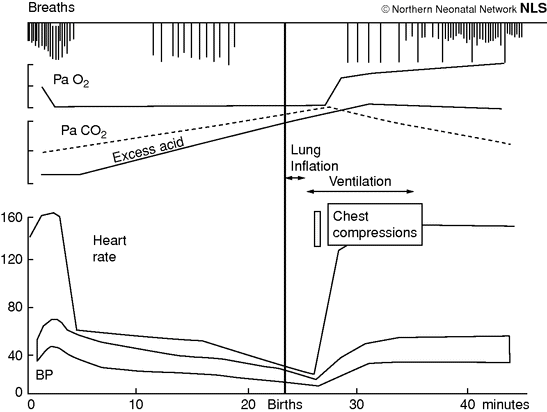
Diagrammatic representation of the physiological response to cardiac compressions in a baby born in early terminal apnoea who has not responded to lung inflation.
This baby will not breathe for itself, and requires us to give five inflation breaths in order to oxygenate it and then allow an improvement in the heart rate. Let us consider that we have given the baby five inflation breaths and we are certain that we have seen good chest wall movement. Our assessment of effectiveness of the resuscitation thus far is to assess the heart rate, but in this case there has been no increase. The heart rate is still at 40 bpm, for example. Why is this, and what do we need to do?
What we can assume is that this heart has been too compromised by the episode of intrapartum asphyxia. It has failed to respond to the effective inflation breaths. This tells us that this baby requires a short (30 s) period of cardiac compressions in order to try to move blood from the pulmonary vasculature into the coronaries so that the oxygen given with successful inflation breaths can get into the coronaries and give the heart the bump-start it needs.
Chest compressions are best given with two hands encircling the chest wall. Fingers at the back, thumbs at the front. The thumbs should be on the lower third of the xiphisternum on a point one finger’s breadth below an imaginary line drawn between the baby’s nipples. The compressions should be about one-third of the depth of the chest to the baby’s spine (Figure 26.9).
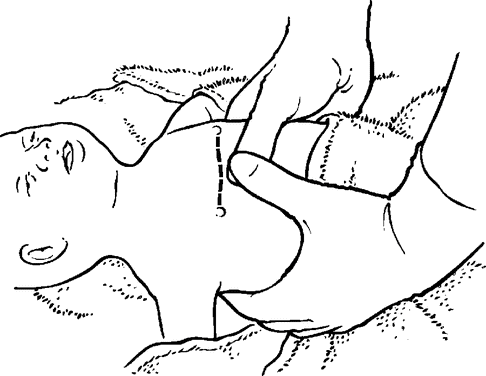
Position for two-handed chest compressions when standing at the side or foot of the baby.
The compressions should be given in a ratio of 3:1 with short ventilation breaths. A total of 120 events in a minute should be the aim – but the quality of the compression and ventilation is probably more important than the quantity [10]. They should be continued for 30 s and then the baby reassessed. Hopefully, there will have been an increase in the heart rate and the baby will be becoming pink and active. If not, and one is happy that chest wall movement is effective and compressions are adequate, one should consider the use of drugs after gaining venous access via the insertion of an umbilical venous catheter (UVC). Such action would almost certainly be the domain of the neonatal team, but with more trainees spending some time in neonatal training posts or attending Newborn Life Support courses, it would not be inappropriate for an obstetrician, midwife or anaesthetist with some UVC experience to insert the line. One would consider using sodium bicarbonate, adrenaline and dextrose as part of the resuscitation. In babies remaining pale and bradycardic, one should always consider blood loss, and in such cases volume (O negative blood) can be life-saving.

Placing the head in the neutral position using chin lift.
All this can be summarized in the algorithm shown in Figure 26.11. This is the 2010 UK Resuscitation Council newborn life support algorithm for the resuscitation of the newborn baby.
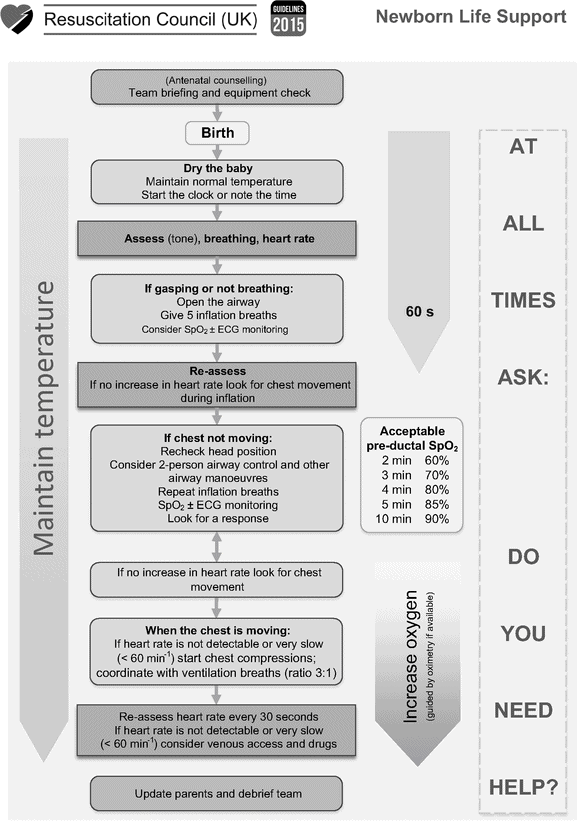
Newborn Life Support Algorithm 2015 © Resuscitation Council (UK).
Opening the Airway
The neonate has a relatively large occiput and if the infant is floppy this often results in the neck flexing the chin onto the chest wall, leading to obstruction of the airway. In such cases, one needs to be able to open the airway using simple manoeuvres. The simplest manoeuvre is the ‘chin lift’, which simply puts the newborn baby’s head into a neutral position, opening the airway and allowing the baby to take in air if it is making any sort of respiratory effort (Figure 26.10). Note that in opening the airway, the baby’s face should be parallel to the surface on which it is being resuscitated, with the eyes looking straight upwards. This is different from the adult position, where the neck is extended with the patient ‘sniffing the morning air’. Figure 26.10 illustrates the correct position of the newborn baby’s head to achieve the neutral position.
If this fails to allow air entry, one can consider the jaw thrust manoeuvres described above.
Whatever the condition of the baby at birth, it is vital to remember that the baby will be wet and have a large surface area to body mass ratio. These two issues mean that the baby will lose heat very quickly. A cold, wet baby is much more difficult to resuscitate than a warm, dry baby.
For the newborn term baby, it is important that the baby is wiped and dried and wrapped in warm towels as quickly as possible after birth, particularly if it has not established a normal breathing pattern. Remember particularly to dry the head and, if need be, place a hat on the baby’s head. Premature infants are now placed into warming bags undried, which has shown to be an effective method of conserving heat for the baby. The use of a warmer bag is only advocated if the baby will remain under an overhead radiant heater which would allow the child to maintain warmth or they were able to go into contact with their mother for warmth. If a radiant heater is not available, then even the premature baby should be towelled dry and wrapped in warm, dry towels using a hat in the same way as the term baby.
Stay updated, free articles. Join our Telegram channel

Full access? Get Clinical Tree


